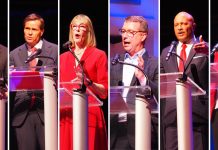Exhibit Columbus was described from the beginning as a project that would create new ways for residents and visitors to experience the city and its famed architectural heritage.
And as the project approaches its final three weeks, organizers say it has far exceeded any expectations for the three-month exhibition of 18 outdoor, site-responsive installations placed near Columbus architectural landmarks.
When Exhibit Columbus is paired with Columbus’ other firsts in 2017, native son Mike Pence taking office as vice president and a movie about the city titled “Columbus,” the impact for the city is astounding, Columbus Area Visitors Center Director Karen Niverson said.
Visitors center traffic increased 71 percent in September and October after Exhibit Columbus opened, representing 7,866 people hosted by the center in the two months compared to 4,603 in the same period last year.
“That’s a huge bump in visitors center traffic,” Niverson said, and perhaps doesn’t totally reflect the influx of visitors, as not everyone who visited the city for Exhibit Columbus stopped in the center.
“That’s a large number of local families coming downtown as well as a significant number of out-of-town visitors,” Niverson added.
An estimated 40,000 people have seen the Exhibit Columbus installations so far, said Richard McCoy, director of Landmark Columbus, whose team organized the effort, described as “an annual exploration of architecture, art, design and community.”
And that doesn’t include the tens of thousands who have not visited in person, but visited online at Exhibit Columbus’ website, where photographs and videos give viewers a sense of visiting the installations.
“We’ve had lots of groups recently — museum groups, university students and a number of architectural firms have come in bunches,” McCoy said. “If the weather is nice, I think we could see another 4,000 to 7,000 people in town before the exhibit closes (on Nov. 26).”
The visitors center distributed 4,000 Exhibit Columbus maps in September and October and hosted 450 Exhibit Columbus walking tours, which were specifically tied to the installations and their significance, Niverson said.
Exhibit Columbus organizers initially predicted last September that about 10,000 people would visit the installations. They haven’t even begun to estimate the economic impact yet, McCoy said.
“It will be substantial but numbers only tell a simple kind of story,” McCoy said.
Many cultural organizations and educational institutions in the Columbus community are creating related programming this fall for Exhibit Columbus visitors, in part through the Heritage Fund’s “Welcoming Community Grant Program,” McCoy said.
Dance Kaleidescope performed at several installations earlier this fall, and a sold-out run of the play “The Laramie Project” was just completed, he said.
That programming has enhanced the experience of visiting Columbus this fall, and shown again and again what makes the community so special, McCoy said.
“I’d put this fall up against Indianapolis or Louisville in scope and scale, any day,” he said of what there was to do in Columbus in addition to viewing the installations.
New perspective
But in addition to that, McCoy said he believes the installations, along with the movie “Columbus,” have changed the way residents view the city where they live.
“The town feels different — there’s a kind of optimism today that wasn’t here a few years ago. There are a number of things that are hitting at just the right time. The creation of a new Indiana University masters of architecture program and the ‘Columbus’ movie makes the architecture look so amazing. What a stroke of luck it has been to bring these things together.”
The Exhibit Columbus program was organized through Landmark Columbus, a nonprofit dedicated to caring for the city’s architectural heritage, which is under the umbrella of Heritage Fund — The Community Foundation of Bartholomew County.
The concept is to alternate between a symposium and an exhibition each year. This year is the first to have architectural installations placed throughout the community.
The Indianapolis-based Efroymson Family Fund is the 2017 Exhibition Presenting Sponsor by virtue of $250,000 it provided in seed money and a challenge grant given in fall of 2014. But the event also has a broad range of financial support from other foundations, businesses, corporations and donors, according to organizers.
Tracy Souza, president of the Heritage Fund, which was instrumental in fundraising for Exhibit Columbus, said she was very pleased with the success of Exhibit Columbus and its reach into not just Indiana or the United States, but the world.
“We really have had two audiences,” she said, “the national and international design architectural audience and also a local one. And nobody knew exactly what it was when it started — we were just running around raising money for it and before the installations were actually here, it was hard to get a sense for what it was going to be.”
But visitors have been surprised at Exhibit Columbus’ scope and reach — the project has been featured in The New York Times, Architectural Digest and the Wall Street Journal, publications with national and international reach.
On Oct. 23, “Columbus” star John Cho, who spent some time filming the movie here in 2016, talked about Columbus, Indiana, on “Late Night with Seth Myers,” mentioning the city’s distinctive architecture and how much he enjoyed filming the movie here.
“It’s amazing that we can get someone like John Cho to endorse our product,” Niverson said of the actor’s fondness for Columbus.
“Exhibit Columbus has a lot of components — it’s like an octopus,” Souza said, laughing a bit at her analogy. “We have tentacles everywhere.”
Those tentacles have included dog shows and fashion shows on “Conversation Plinth” on the Bartholomew County Library plaza, a Miller Prize winner by IKD that also features dramatic lighting.
Wedding parties at nearby First Christian Church have used the Plinth as a backdrop for photos and Bartholomew Consolidated School Corp. students have used it to learn how bubbles float from its top steps.
“Another Circle” in Mill Race Park, another Miller Prize winner by ArandaLasch, has generated more foot traffic into Mill Race Park.
Groups have gathered in “Wiikiaami,” a towering tepee-like structure designed by studio:indigenous, which was constructed with the help of Faurecia welders. In addition to being a gathering place, the structure is also a gateway to nearby First Christian Church.
“People are paying attention again to Columbus,” McCoy said of how people are drawn to the architecture and design in the city. “We’ve helped rebuild the cultural identity of this city around architecture and that’s a great message to have out there.”
And Exhibit Columbus’ popular Drinking by Design events, meetups at Columbus Upland Pump House and other locations for community residents and visitors to meet with designers about their projects, have been instrumental in connecting people to Columbus’ architecture, Souza said.
McCoy acknowledges there have been many good conversations over a beer or a soda, created as an informal way to grow a group that cares about the value of good design and how it can shape a community.
The Drinking by Design idea is also being used to provide more connection throughout the community, McCoy said.
On Oct. 23, Harshal Keskar, a long-time Columbus resident who has been instrumental in art design for Indian festive events in the community, was the Drinking by Design guest speaker, talking about his elaborate tableaus each year for the Ganesh festival.
“I think there are new ways we can connect across the community around design,” McCoy said.
Lasting impact
Souza credits McCoy and his team with re-energizing the community to connect with its design heritage through Exhibit Columbus.
“Richard and his team are open to going anywhere and showing up and talking about Exhibit Columbus,” she said. “They live and breathe this thing. Richard is invested hook, line and sinker and his team is, too.”
There are rumors circulating in the community that some of the Exhibit Columbus installations might find new homes in Columbus, but Souza is unsure just how serious any of that talk is.
“The Exchange,” a white geometric fabricated space created by the Oyler Wu Collaborative next to the Irwin Conference Center that highlights its history of having a bank drive-thru, is rumored to possibly be staying, and people are asking if “Wiikiaami” might find another location for its new home in Columbus, Souza said.
“But we’re not sure if people are truly serious about it at this point,” she said.
McCoy said residents should “stay tuned,” about these possibilities.
“We created this project to be temporary and to return these iconic sites back to normal,” he said. “I’m looking forward to that part. But yes, we are considering if any can stay.”
Mayor Jim Lienhoop said he believes 2017 will be remembered as a pivotal year in Columbus for the exposure that Exhibit Columbus brought nationally and internationally and the number of visitors who came to the city to check out the architecture and ambiance.
More national notoriety is upcoming as the city continues to assist Indiana University as it sets up the logistics for a new Master of Architecture program in Columbus.
The IU School of Art and Design, created by joining the Department of Studio Art and the Department of Apparel Merchandising and Interior Design, plans to use the IU Center for Art + Design Columbus to host its proposed master’s of architecture degree.
The degree program was approved earlier this year and T. Kelly Wilson, director of the IU Center for Art + Design Columbus, is currently recruiting students for the program, which could launch as early as fall of 2018.
“Exhibit Columbus was created in part to answer the question, ‘What’s next for Columbus?’” Lienhoop said in promotional materials for the architectural exhibit. “We want this initiative (Exhibit Columbus) to become a platform to showcase our historic design heritage and community spirit, while pointing to the future so the next generation continues to experience a community of tremendous vibrancy, just as the last generation did.”
[sc:pullout-title pullout-title=”Upcoming Exhibit Columbus events” ][sc:pullout-text-begin]
The following events are planned as Exhibit Columbus completes its run, continuing through Nov. 26 in Columbus.
Artist Talk: The View from Treviso, Drawings of Columbus
When: 5 to 7 p.m. Thursday
Where: Gallery 506 at the Columbus Visitors Center, 506 Fifth St.
How much: Free
Details: Opening reception and artist talk by architect, artist and author Guglielmo Botter, who will exhibit a series of pen and ink drawings at Gallery 506 through the end of 2017. Botter’s talk is being conducted in partnership with Exhibit Columbus’ ongoing Drinking About Design series, which are meet-ups in locations around Columbus to talk about the design behind the local exhibits. Drawings in Botter’s show were created during two previous visits to Columbus, where he sketched and photographed community landmarks and many of the Exhibit Columbus installations.
WellConnect Artist Reception
When: 5 to 6:30 p.m. Friday
Where: WellConnect, 237 Washington St.
How much: Free
Details: This reception will commemorate Exhibit Columbus featuring Ivy Tech Community College – Columbus students partnering to develop an interpretive display of “color and form” to be exhibited at WellConnect. Exhibit Columbus was used as a contextual inspiration for the students to explore design and color principles.
Drinking About Design: Brunch Edition
When: 11 a.m. to 1 p.m. Saturday
Where: Henry Social Club, 423 Washington St.
How much: $30, limited-seating event, reservations required, to make a reservation call the club at 812-799-1371
Details: Anne Surak, director of exhibitions for Exhibit Columbus, will share the thought process behind the site-based Exhibit Columbus installations and the conversations they have sparked in Columbus and beyond. A brunch entree, mimosa, coffee and a sweet pastry is included with your reservation.
Miller Prize Talks: Chris Cornelius
When: 4:30 to 5:30 p.m. Nov. 18
Where: First Christian Church, 531 Fifth St., at Exhibit Columbus “Wiikiaami” installation, which Cornelius designed
How much: Free
Details: Chris Cornelius, of studio:indigenous, will talk about his installation “Wiikiaami,” a Miller Prize winner, which is inspired by the dwellings of the Myaamia people who were indigenous to Indiana. The exhibit was envisioned as a contemporary wigwam that would serve as a gathering space and gateway to the church. The installation was fabricated on site in collaboration with a team of Faurecia welders. The 30-foot-tall structure has elegantly curved rebar covered by sheets of metal scales made by Ignition Arts, Indianapolis.
[sc:pullout-text-end][sc:pullout-title pullout-title=”Where to learn more” ][sc:pullout-text-begin]
To learn more about Exhibit Columbus and the installations, visit exhibitcolumbus.org.
[sc:pullout-text-end][sc:pullout-title pullout-title=”Give some feedback” ][sc:pullout-text-begin]
Every visitor to Exhibit Columbus has a chance to leave a comment about what they are observing as they tour the installations.
To listen to a guided tour of Exhibit Columbus and the comments of others who have traveled before you, download the Exhibit Columbus APP Hear/Here from the iTunes store.
As you get close to an installation or a historic Columbus location, you will hear audio about the location and new content from others who have already visited. Visitors may answer one of the questions on the app or talk of memories you have of a particular location.
The app is best experienced using stereo headphones. Hear/Here was created by Halsey Burgundy, a sound artist based in Boston, Massachusetts.
[sc:pullout-text-end][sc:pullout-title pullout-title=”What you might have missed” ][sc:pullout-text-begin]
Columbus is home to several legendary public sculptures, among them Henry Moore’s bronze sculpture “Large Arch” (1971) and Jean Tiguely’s “Chaos I” (1974), a late modernist kinetic sculpture composed of found and repurposed steel located at The Commons.
Exhibit Columbus, in a collaboration with Cummins Inc., Indiana University Center for Art + Design (IUCA+D) and Indiana University, have “Shadow of an Unknown Bird” on display through Nov. 30 at the IUCA+D, 310 Jackson St.
It is one of the largest 3-D printed works of art in the world, according to Exhibit Columbus organizers. It was constructed using recent innovations in 3-D printing called BAAM (Big Area Additive Manufacturing).
The sculpture, by architects Jee Yea Kim and T. Kelly Wilson, artist Jennifer Riley, engineers John Rupp, Roger England and John Allman and business leader Phil Shelton, is designed to reflect the technological and artistic advancements of our time, using 3-D printing, digital metrology and water-jet and plasma cutting.
Draftsmen and those involved in assembly were Drew Calbert, Carl Jackson, Levi Fischer, Harvey Bailey, Tony Vasquez, Andy Helwig, Evan Berkemeier and intern Elise Dean-Wolf.
[sc:pullout-text-end]




